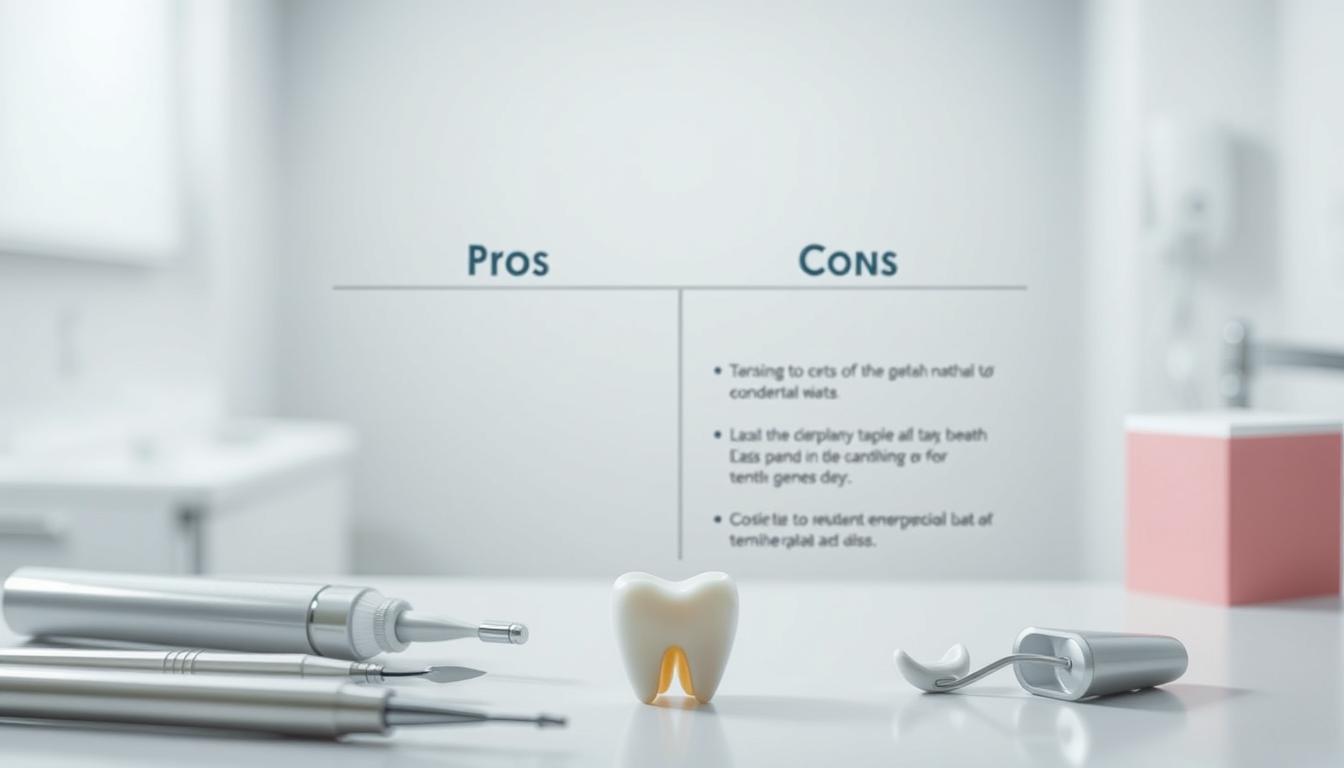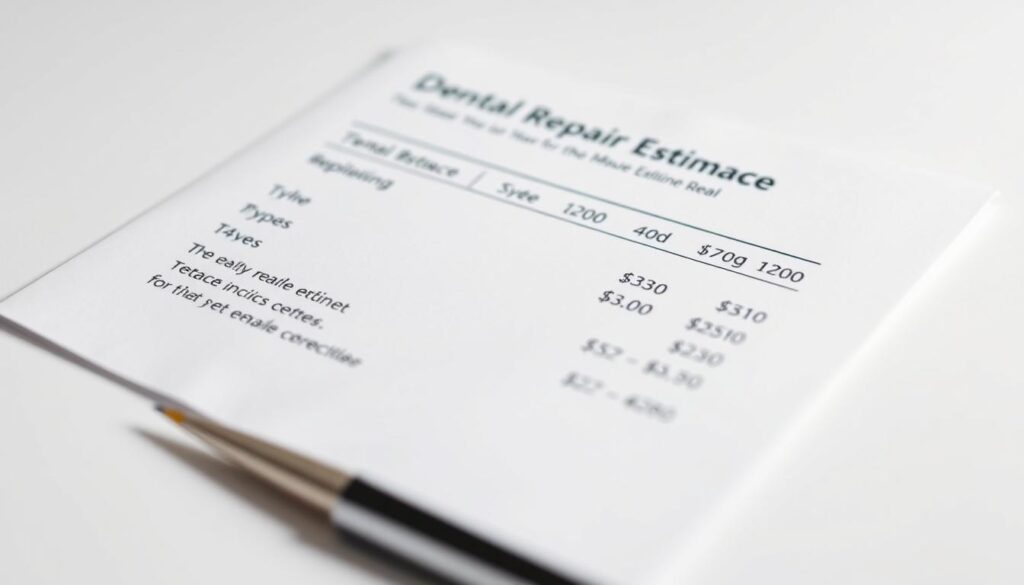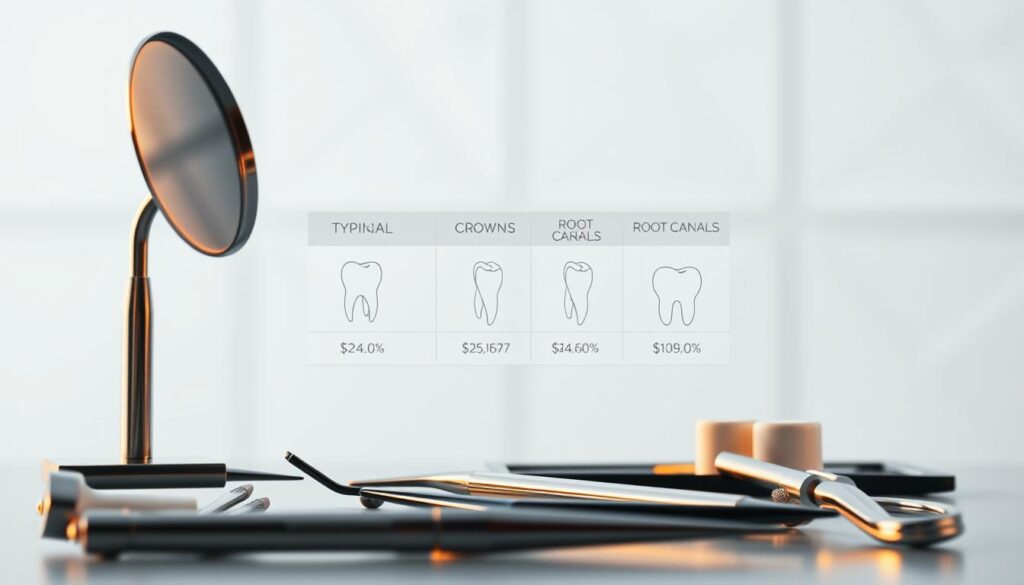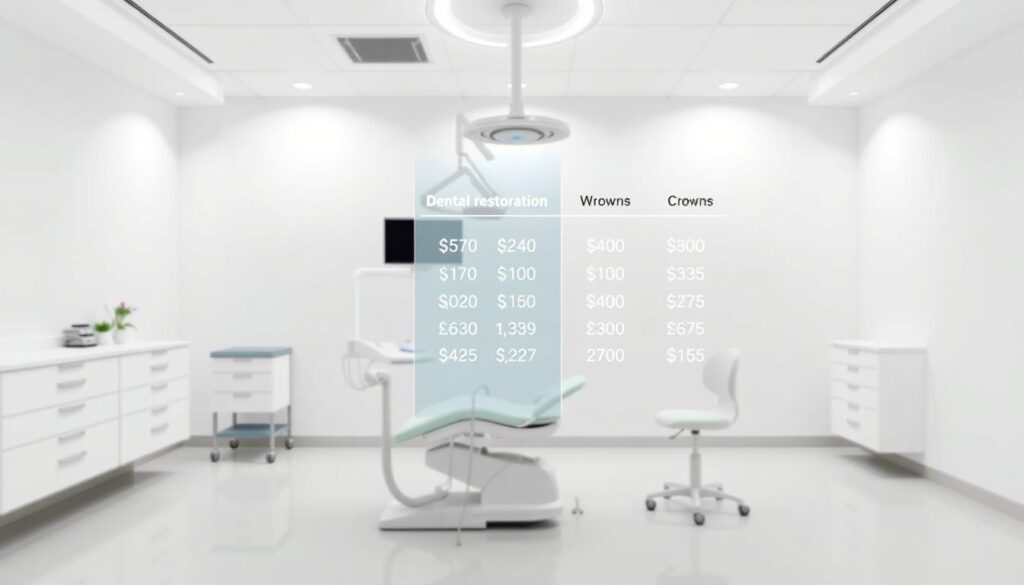How Much Does It Cost to Fix a Broken Tooth?

About 5 million Americans get broken or chipped teeth each year. This raises a big question: How much does it cost to fix a broken tooth? The price depends on where the tooth is and what materials are used for the fix. Many people ask if getting treatment quickly matters.
Every broken tooth needs a special fix. The cost can change based on the tooth’s spot in your mouth or how complex the repair is. Knowing the basics helps with planning your budget and getting better results.
Key Takeaways
- Position of the tooth often influences total expense
- Restoration materials determine durability and fees
- Minor fractures may need simple bonding, while severe breaks require advanced procedures
- Insurance plans help reduce costs but have specific coverage limits
- Early treatment prevents worsening damage and higher future expenses
Understanding the Basics of Tooth Repair Costs
Experts say quick action is key when teeth get damaged. Waiting too long can mean more costly fixes. Regular dental check-ups can catch problems early.
Many wonder about the cost of fixing a broken tooth. Prices vary with the extent of damage and the chosen fix.
Common Types of Dental Repairs
Dentists use different methods to fix teeth:
- Dental bonding for small chips and surface imperfections
- Fillings to address minor cavities or damage
- Veneers for moderate cosmetic fixes
- Crowns to strengthen severely compromised teeth
“A thorough oral examination is one of the most effective ways to detect damage early,” states a leading dentist at Mayo Clinic.
The right fix depends on the tooth’s spot and how bad the damage is.
Factors Affecting Repair Costs
Several things influence the cost:
- Damage severity and needed materials
- Dental location (front tooth or molar)
- Clinician specialization and lab fees
Getting help from a trusted dentist is important for safe fixes. Knowing these factors helps plan for the cost. This way, people can feel more confident about their dental care.
Estimated Costs for Common Procedures
Many people want to know the cost before they book an appointment. The price can change, but thinking about the long-term benefits helps. It’s wise to look at each option carefully.

Minor fillings can fix small cavities or chips. They involve preparing the tooth and then filling it with a material. These materials can last longer or look more natural.
Fillings: Cost and Implications
Fillings are often the most affordable choice. But, the price can vary based on how bad the decay is. They help keep your tooth working right and prevent bigger problems.
Crowns: When Are They Necessary?
Doctors recommend crowns for serious damage or after a root canal. A crown helps you chew better and protects your tooth. But, it costs more because of the lab work and preparation needed.
Root Canals: Understanding the Expense
A root canal is needed when the pulp gets sick or inflamed. It removes the bad tissue and saves your tooth. Remember, getting a crown after a root canal will add to the cost.
| Procedure | Approximate Range (USD) |
|---|---|
| Fillings | 100 – 300 |
| Crowns | 800 – 1,500 |
| Root Canals | 700 – 1,200 |
Insurance Coverage for Dental Repairs
Getting dental care without surprise costs is key. Knowing what your insurance covers helps manage costs. Each insurance plan has its own rules, but some things are usually the same.

Most plans have rules for different types of care. They break down into preventive, basic, and major treatments. This helps you know what you’ll pay before you get care.
What Do Most Dental Plans Cover?
Most plans help pay for fillings and crowns. They might also cover some root canals or special treatments. But, cosmetic fixes might need extra coverage or a higher plan.
Each insurance company has its own rules. These depend on the plan level and who they work with.
How to Navigate Your Insurance Benefits
Finding the best way to use your insurance can save you money. Here’s how:
- Read your plan documents to know what’s covered and what’s not.
- Call customer service if you have questions about certain treatments.
- Make sure your dentist is in-network to get the best payment from your insurance.
| Procedure | Average Coverage | Patient’s Share |
|---|---|---|
| Fillings | 70–80% | 20–30% |
| Crowns | 50–60% | 40–50% |
| Root Canal | 50–70% | 30–50% |
Out-of-Pocket Expenses: What to Expect
Many patients face unexpected bills even with insurance. Deductibles and copayments can add up quickly. So, people often look for affordable tooth repair solutions to keep costs predictable.
This approach involves understanding the range of expenses across different areas. It also means exploring various payment methods that ease the financial load.
Average Costs by Geographic Region
Expenses vary from state to state. East Coast cities tend to have higher fees compared to the Midwest. In places where overhead is high, a simple procedure may cost hundreds more than in less populated areas.
Payment Plans and Financing Options
Flexible plans can lighten the impact of larger procedures. Some practices join with third-party lenders, allowing monthly installments for urgent treatments. Others offer in-house financing, reducing upfront charges.
This strategy supports timely care without straining household budgets. It also helps make affordable tooth repair more accessible.
| Region | Potential Out-of-Pocket Range |
|---|---|
| East Coast | $150–$400 per procedure |
| Midwest | $100–$300 per procedure |
| West Coast | $200–$450 per procedure |
Types of Dental Professionals Involved
Dentists have different levels of expertise, which affects the cost of tooth repair. Some patients see one dentist, while others need help from specialists for complex issues. The right choice depends on the damage and the dentist’s skills.

General Dentists vs. Specialists
General dentists handle routine care and simple repairs. They often do fillings and pull teeth. Specialists, on the other hand, deal with complex tasks. For example, endodontists work on root canals, and prosthodontists make advanced crowns or implants.
How Specialty Care Affects Cost
Seeing a specialist can cost more. They have more training, use special tools, and use better materials. Even though it’s more expensive, the results are often better and last longer.
| Dental Professional | Primary Focus | Common Procedures |
|---|---|---|
| General Dentist | Preventive & Basic Care | Cleanings, Fillings |
| Specialist | Advanced Treatment | Root Canals, Implants |
The Importance of Prompt Treatment
Acting quickly can save you from pain and expensive bills. If you don’t treat a fracture, it can get worse. This might lead to inflammation or infection, needing more care later.

A study by the American Dental Association shows the value of quick action. Small chips can turn into big cracks, needing root canal therapy or tooth removal. Waiting can turn a simple visit into a series of complex treatments. For more information, check out this resource.
Risks of Delaying Dental Repairs
What happens if you ignore a crack in your tooth?
- Enlarged cavities that weaken tooth structures
- Bone deterioration leading to tooth loss
- Abscesses that affect overall health
Ignoring early signs can lead to more problems than fixing it right away. Ignoring a small issue can cause widespread infection. This can lead to expensive treatments that harm your wallet and health.
Long-term Costs of Ignoring Dental Issues
A dental cost breakdown shows ignoring dental problems can be costly. Our goal is to keep your teeth healthy before small issues become big problems. Early treatment saves your smile, reduces future costs, and keeps you worry-free.
Comparing in-Office vs. Online Treatment Options
In-office visits are great for those who need a hands-on approach. They use advanced tools to find tooth problems quickly.

Advantages and Disadvantages
Virtual checkups are popular for quick advice. You can book them from home, saving time for simple questions or follow-ups.
- Immediate feedback from trained professionals
- No commute, lowering overall stress
- Limitations with hands-on procedures
Cost Comparisons for Virtual Consultations
Online appointments can help save on dental costs for simple needs. But, complex treatments like crowns or implants need in-person care. It’s a trade-off between convenience and the need for precise tools.
Emergency Dental Care: Pricing Insights
Sudden tooth cracks or severe infections need quick help. Unexpected costs may come up for late-night or weekend visits. Sometimes, sedation is used to manage pain and comfort.
Fixing a broken tooth quickly is key. Waiting can make things worse and cost more in the long run. Many people seek help fast to avoid pain and protect their health and wallet.
When to Seek Emergency Treatment
Think about urgent care if you experience:
- Severe bleeding or intense throbbing
- Visible swelling or infection risk
- Debilitating pain that disrupts daily routines
Average Costs of Urgent Repairs
Prices change based on the problem’s complexity. Simple fixes or temporary solutions are usually cheaper. More complex issues, like root canals, cost more. Many clinics give detailed cost estimates to help with planning.
Acting fast can prevent bigger problems and save on future dental work.
Alternative Treatment Options
People looking for more ways to keep their teeth healthy often try new methods. They might use botanical mouth rinses or special diets to ease pain. These approaches can help with minor issues without replacing doctor visits.

Holistic Approaches to Tooth Repair
Holistic methods aim for overall health, including natural supplements and gentle techniques. Some use essential oils, oral exercises, or laser therapy. These methods help keep gums healthy and fight inflammation.
- Herbal extracts that calm sensitive tissues
- Guided relaxation to ease dental anxiety
- Dietary adjustments that promote enamel strength
Cost Comparison of Traditional vs. Alternative Methods
Costs differ, and some might choose natural methods for small issues. But, serious problems need fillings or crowns. It’s smart to look at costs and safety, as shown in this guide on urgent dental care. Always get a doctor’s opinion, though, for serious tooth problems.
Discounts and Promotions
Is there a better way to keep teeth strong without draining personal savings? Many offices now feature creative plans that ease financial stress. Special offers often include limited-time deals or loyalty incentives that reduce fees for exams and cleanings.
Some dental providers collaborate with established insurers such as Delta Dental and Cigna. These alliances offer patients lower rates on selected services and help them stay on track with regular check-ups. A well-designed plan may even cut costs for fillings and other care.
Finding Deals at Local Dental Clinics
Local clinics can run holiday promotions or new-patient specials that ease entry into treatment. Dental schools sometimes open their training programs to the public, giving learners hands-on experience under expert supervision. Neighborhood health fairs can also present access to affordable check-ups and preventive work.
Membership Plans for Families
Group subscriptions are common tools for lowering expenses. Some include:
- Reduced rates on restorations
- Free annual cleanings for children
- Priority appointments for urgent care
Family plans often cover multiple individuals while keeping monthly fees manageable. This approach inspires consistent follow-up and helps households prepare for unexpected dental challenges.
The Role of Dental Hygiene in Repair Costs
Good daily habits can save you money. Brushing and flossing well keep teeth strong. Regular dentist visits catch problems early, avoiding expensive fixes.
Studies show that being proactive can prevent chronic pain and costly treatments.
Preventive Care to Reduce Future Expenses
Brushing right and using antibacterial mouthwashes can stop plaque. Catching small cavities early means quick fixes, not big repairs. Good care includes:
- Using fluoride toothpaste to strengthen enamel
- Maintaining balanced diets free from excessive sugars
- Scheduling regular professional cleanings
Investment in Oral Health for Long-term Savings
Regular dental exams make your budget more predictable and comfortable. Prioritizing oral health means fewer big repairs. This reduces stress and keeps your treatment costs stable.
| Dental Hygiene Action | Primary Benefit | Impact on Repair Costs |
|---|---|---|
| Routine flossing | Removes hidden debris | Decreases need for fillings |
| Regular checkups | Early detection | Limits major procedures |
| Fluoride treatments | Reinforced enamel | Protects against fractures |
Questions to Ask Your Dentist
Before you decide on a dental procedure, it’s smart to ask important questions. Talking things over can avoid unexpected costs and make sure you both are on the same page. Clear cost breakdowns and schedules are key, as insurance issues can sometimes delay things.
How to Get a Clear Estimate
Getting a detailed quote is a good idea. It should list each procedure’s cost. In places that work with Delta Dental or Cigna, staff can give you a detailed breakdown. Make sure to ask about sedation, materials, and lab fees.
Consider these questions:
- Is diagnostic imaging part of the total?
- Can extra visits affect the projected bill?
- Are payment plans or financing options available?
Understanding the Treatment Plan
Many dentists explain each step, from X-rays to follow-up visits. These steps help spot any issues early. The materials used, like porcelain or composite resin, can change the cost.
Talk about sedation and aftercare to avoid surprise costs. Being open helps build trust and confidence in the dental process.
Maintaining Your Dental Work
Keeping your dental work in good shape requires effort. Every dental treatment, from fillings to crowns, needs regular care. Simple cleaning and watching for signs can stop small problems from getting worse.
Regular Check-ups and Their Costs
Regular dental visits are key to keeping your repairs in great condition. They help catch problems early, like hidden cracks or weakening. A quick check-up and cleaning is cheaper than emergency visits. By scheduling dental check-ups regularly, you can save money and keep your teeth healthy.
Tips for Extending the Life of Repairs
Simple habits can make your dental repairs last longer. An attentive oral care routine helps prevent plaque and decay. Wearing mouthguards protects your teeth from injury. Also, avoid eating foods that are too sticky or hard.
- Use a soft-bristled toothbrush
- Maintain balanced nutrition
- Watch for any discomfort or sensitivity
| Maintenance Activity | Primary Benefit |
|---|---|
| Frequent brushing | Limits plaque near repaired areas |
| Professional cleanings | Removes stubborn tartar |
| Periodic X-rays | Identifies hidden flaws early |
Alternative Materials for Tooth Repair
Choosing the right material for tooth repair can affect how long it lasts and how it looks. Each material has its own strengths for both durability and looks. This makes it important for both doctors and patients to understand the costs.
Comparing Costs of Different Materials
Ceramic restorations, like those from Ivoclar Vivadent, often look very natural. But, they can be more expensive. Porcelain is great for matching tooth color, but it can cost more than resin.
On the other hand, metal-ceramic options are strong and don’t break the bank. But, the metal part might change how the tooth looks over time. Resin products from 3M are often cheaper and can be applied quickly.
Pros and Cons of Each Option
| Material | Aesthetic Factor | Durability | Cost Range |
|---|---|---|---|
| Porcelain | High fidelity | Moderate | Mid to High |
| Ceramic | Natural translucence | Strong under pressure | Higher tier |
| Metal-Ceramic | Less natural in front teeth | Robust | Mid range |
| Composite Resin | Color blend | Moderate lifespan | Lower cost |
Conclusion: Making Informed Choices
Choosing the right way to fix a broken tooth is not just about the price. It’s about making choices that keep your teeth healthy, use your insurance wisely, and fit your needs.
Weighing Cost Against Quality of Care
Some people choose cheaper dental fixes, but the best results come from skilled care. Using the right materials and finding trusted dentists is key. Always check your insurance first to avoid surprise costs.
Developing a Long-term Dental Care Plan
Smart budgeting and prevention lead to better dental health. Regular dental visits can spot problems early, saving money in the long run. A good dental plan includes cleanings, good hygiene, and follow-ups. This keeps your teeth healthy and your wallet happy.


